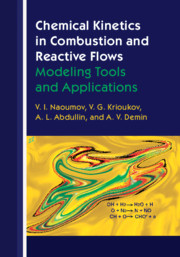Refine search
Actions for selected content:
8126 results in Fluid dynamics and solid mechanics
Nomenclature
-
- Book:
- Chemical Kinetics in Combustion and Reactive Flows
- Published online:
- 16 August 2019
- Print publication:
- 22 August 2019, pp xxi-xxvi
-
- Chapter
- Export citation
Dedication
-
- Book:
- Chemical Kinetics in Combustion and Reactive Flows
- Published online:
- 16 August 2019
- Print publication:
- 22 August 2019, pp vii-viii
-
- Chapter
- Export citation
9 - Pressurization of Liquid Propellant Rocket Engine Tanks
- from Part III - Simulation of Combustion and Nonequilibrium Flows in Propulsion and Power Generation Systems
-
- Book:
- Chemical Kinetics in Combustion and Reactive Flows
- Published online:
- 16 August 2019
- Print publication:
- 22 August 2019, pp 334-379
-
- Chapter
- Export citation
7 - Simulation of High-Temperature Heterogeneous Reacting Flows
- from Part III - Simulation of Combustion and Nonequilibrium Flows in Propulsion and Power Generation Systems
-
- Book:
- Chemical Kinetics in Combustion and Reactive Flows
- Published online:
- 16 August 2019
- Print publication:
- 22 August 2019, pp 283-309
-
- Chapter
- Export citation
10 - Combustion and Ionization in Spark Ignition Engines
- from Part III - Simulation of Combustion and Nonequilibrium Flows in Propulsion and Power Generation Systems
-
- Book:
- Chemical Kinetics in Combustion and Reactive Flows
- Published online:
- 16 August 2019
- Print publication:
- 22 August 2019, pp 380-396
-
- Chapter
- Export citation
8 - Simulation of Two-Phase Flows in Gas Generators of Liquid-Propellant Rocket Engines
- from Part III - Simulation of Combustion and Nonequilibrium Flows in Propulsion and Power Generation Systems
-
- Book:
- Chemical Kinetics in Combustion and Reactive Flows
- Published online:
- 16 August 2019
- Print publication:
- 22 August 2019, pp 310-333
-
- Chapter
- Export citation
Part I - Basic Components of Chemical Nonequilibrium Models
-
- Book:
- Chemical Kinetics in Combustion and Reactive Flows
- Published online:
- 16 August 2019
- Print publication:
- 22 August 2019, pp 1-204
-
- Chapter
- Export citation
Copyright page
-
- Book:
- Chemical Kinetics in Combustion and Reactive Flows
- Published online:
- 16 August 2019
- Print publication:
- 22 August 2019, pp vi-vi
-
- Chapter
- Export citation
2 - Governing Equations of Chemical Kinetics and Specific Features of Their Solution
- from Part I - Basic Components of Chemical Nonequilibrium Models
-
- Book:
- Chemical Kinetics in Combustion and Reactive Flows
- Published online:
- 16 August 2019
- Print publication:
- 22 August 2019, pp 41-94
-
- Chapter
- Export citation
Reviews
-
- Book:
- Chemical Kinetics in Combustion and Reactive Flows
- Published online:
- 16 August 2019
- Print publication:
- 22 August 2019, pp i-ii
-
- Chapter
- Export citation
6 - Models of Droplet Evaporation in Gas Flow
- from Part II - Mathematical Modeling of Selected Typical Modes of Combustion
-
- Book:
- Chemical Kinetics in Combustion and Reactive Flows
- Published online:
- 16 August 2019
- Print publication:
- 22 August 2019, pp 262-280
-
- Chapter
- Export citation
References
-
- Book:
- Chemical Kinetics in Combustion and Reactive Flows
- Published online:
- 16 August 2019
- Print publication:
- 22 August 2019, pp 397-417
-
- Chapter
- Export citation
EXISTENCE AND UNIQUENESS OF WEAK AND CLASSICAL SOLUTIONS FOR A FOURTH-ORDER SEMILINEAR BOUNDARY VALUE PROBLEM
- Part of
-
- Journal:
- The ANZIAM Journal / Volume 61 / Issue 3 / July 2019
- Published online by Cambridge University Press:
- 19 August 2019, pp. 305-319
-
- Article
-
- You have access
- Export citation

Chemical Kinetics in Combustion and Reactive Flows
- Modeling Tools and Applications
-
- Published online:
- 16 August 2019
- Print publication:
- 22 August 2019
SELF-EXCITED OSCILLATIONS IN A COLLAPSIBLE CHANNEL WITH APPLICATIONS TO RETINAL VENOUS PULSATION
- Part of
-
- Journal:
- The ANZIAM Journal / Volume 61 / Issue 3 / July 2019
- Published online by Cambridge University Press:
- 15 August 2019, pp. 320-348
-
- Article
-
- You have access
- Export citation
CRITICAL SURFACE CONING DUE TO A LINE SINK IN A VERTICAL DRAIN CONTAINING A POROUS MEDIUM
-
- Journal:
- The ANZIAM Journal / Volume 61 / Issue 3 / July 2019
- Published online by Cambridge University Press:
- 19 July 2019, pp. 249-269
-
- Article
-
- You have access
- Export citation
Index
-
- Book:
- MHD Waves in the Solar Atmosphere
- Published online:
- 15 July 2019
- Print publication:
- 18 July 2019, pp 501-508
-
- Chapter
- Export citation
14 - Solar Applications of MHD Wave Theory
-
- Book:
- MHD Waves in the Solar Atmosphere
- Published online:
- 15 July 2019
- Print publication:
- 18 July 2019, pp 434-488
-
- Chapter
- Export citation
9 - Gravitational Effects
-
- Book:
- MHD Waves in the Solar Atmosphere
- Published online:
- 15 July 2019
- Print publication:
- 18 July 2019, pp 248-280
-
- Chapter
- Export citation
References
-
- Book:
- MHD Waves in the Solar Atmosphere
- Published online:
- 15 July 2019
- Print publication:
- 18 July 2019, pp 489-500
-
- Chapter
- Export citation
